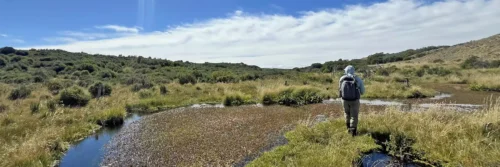Patagonian BaseCamp Trip Report
March 16-23, 2025
by Mike Mercer
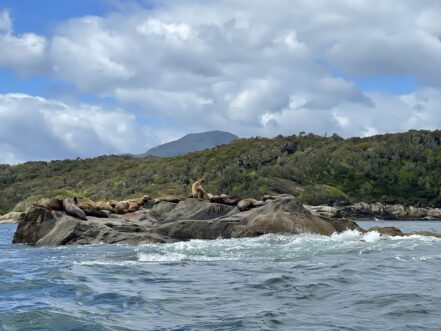
Because in my job I get to travel to the finest fly fishing destinations in the world, I often am asked by prospective fly fishing travelers about my favorite place in the fly fishing universe. Though I love the answer, “Wherever I find myself at the moment,” and believe there is a lot of truth in it, if pressed I will admit that Chilean Patagonia checks all the boxes for me. I first visited this civilized wilderness over three decades ago and was captivated by the enormity of the country itself, the gracious hospitality of the locals, and of course the incredible dry fly fishing. I loved that all the roads were dirt, and that I never saw another angler on any of the rivers fished. Most of all, I was infatuated with the rivers – how utterly pristine they were and how readily even the largest trout there would rise to a hopper pattern or almost any large dry. Fast forward 30 years and there are still a lot of dirt roads, the country remains largely untouched and wild, and the people are just as friendly. And while you may on occasion see another angler on the water you’re fishing, it is more common to have it all to yourself. And after all those years the browns and rainbows of Patagonia still rise just as readily to a dry fly.
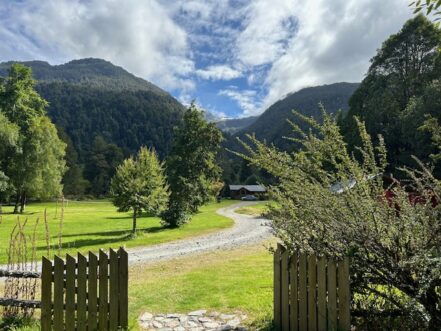
I recently took one of my regular, month-long jaunts down to this very special place, visiting three of the lodges The Fly Shop® represents there – El Saltamontes, Estancia de los Rios, and Patagonian BaseCamp. For the sake of brevity this report will only cover my week at Patagonian BaseCamp, but feel free to contact me anytime with questions you may have regarding any of our Chile or Argentina trout options, as well.
Comfortably ensconced in the front seat of the Toyota Hilux, I watched the incredible scenery unfold as we drove from the arid steppe country of Estancia de los Rios Lodge, through high coastal mountains, and then dropped through the lush and impenetrable rainforests of Queulat National Park. From the backseat my traveling companion on the trip, also Mike, carried on a conversation with our youthful and zealous driver, Jota (pronounced HO-ta, also a guide at EDLR), who with every straightaway was shaving time off our expected arrival time in La Junta, where we had a reservation for the night at a lakeside resort (El Pangue) before heading to our final destination of Patagonian BaseCamp. Just as I thought the country could not be any more beautiful, I was proven wrong as we took a turn and found ourselves staring goggle-eyed out over a portion of Chile’s vast fjordlands – complete with seals and penguins and hanging glaciers. Though I’ve taken the drive many times over the past 20 years, it never loses its magic for me. From the backseat I heard a low “whoa” emanate, and remembered what it was like to see this place for the first time myself, decades ago.
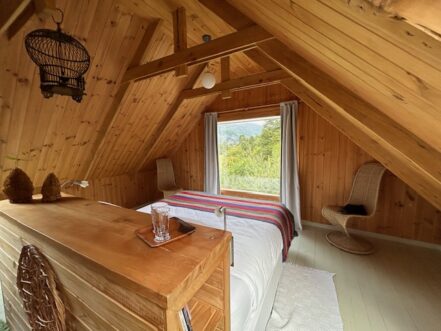
Estancia de los Rios had been amazing, with its close to 700 square miles of high desert spring creeks, rivers, and shallow, brown trout-choked lakes…and we were now headed to Patagonian BaseCamp, famous for its myriad coastal rivers the lodge has discovered and developed over the years. These are world-class trophy trout streams, virtually unknown to most of the fly fishing angling world before lodge owner Marcel Sijnesael arrived on the scene in the late 1990’s. They are rivers that harbor large numbers of trout that would be considered “fish of the day” back home – fat, powerful brown and rainbow trout in the 15-20-inch range – as well as a good number of larger fish, true trophies that cause one to catch their breath when hooked. Best of all, these fish love to eat large dry flies! It is a float fisherman’s dream, drifting daily down some of the most beautiful rivers in Chile.
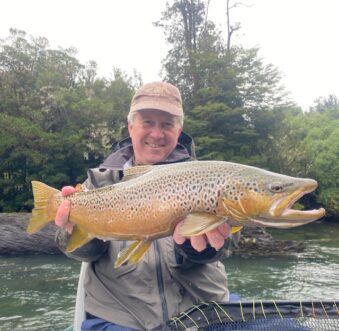
After a pleasant night at El Pangue Resort we were collected by Marcel’s driver, Nico, a young man with a wonderful spirit who operates as a key member of the lodge staff between stints at his “real job” as a school principal and physical education teacher at one of the country’s Montessori schools. On the short drive to the lodge he gave us updates on current fishing conditions, as well as expounding fervently on his mission to bring better health to the country through improved diet and exercise, start
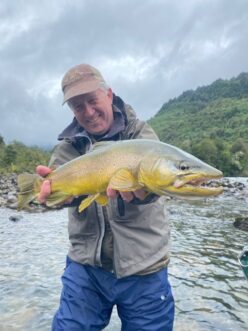
ing with the school children. One couldn’t help but be moved by his passion, and I for one believe he is making a difference! Arriving at the lodge, Marcel and other members of his staff greeted us warmly – these were people who would over the following week become friends. We were shown to our accommodations (everyone gets a private room here, complete with a large en suite bathroom), where we had plenty of time to unpack and prepare our gear for the days to come, and take a hot shower before finding our way to the relaxed gathering room adjacent to the dining area. A large, free-standing fireplace anchors the room, surrounded by leather couches and chairs. The guests for the week slowly filtered in, greeting each other as we found seats around the crackling fire and dove into sumptuous appetizers, washed down by the traditional pisco sours, or if preferred, complimentary wine, beer, spirits or sodas. One is immediately made to feel a welcomed guest here, free to stroll around in socks or the provided lodge slippers, helping yourself at any hour to your choice at the open bar or drink refrigerator. It is all very comfortable and relaxed. One lodge wall is all glass, giving guests a never-ending, birds-eye view of the lovely home water – the Rio Palena – whether devouring the nightly appetizers (empanadas, sushi, and an endless variety of other delectable taste treats), or while enjoying one of the chef’s incredible dinner options. This night we were treated to a delicious first course of a small local fish (Puye), followed by a main course of tenderloin cooked to order (not to mention perfection), along with an incredible mélange of vegetables prepared by the lodge’s Peruvian chef. It was to be the first of many memorable meals, each more amazing than the one before. Following dinner and Marcel’s explanation of how the fishing program would unfold during the week to come, we shuffled off to bed, well-fed and already dreaming of the following day’s fishing.
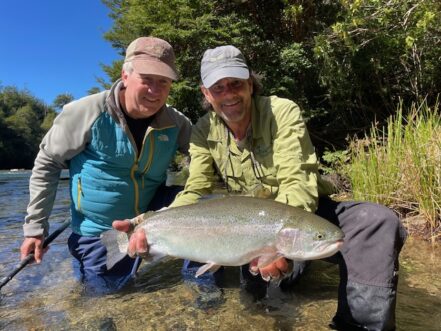
The first day I had the pleasure of fishing with Tom, a longtime travel client of The Fly Shop® (sorry you drew the short straw, Tom!). We were guided by Ben on the Rio Rosselot, a river I knew from past trips to be a fish factory, filled with trout more than willing to eat large dries, and dry dropper rigs all day long. The day did not disappoint, starting with a double hookup before we had even left the headwaters lake where the float begins! There were more of these to come – most fish were in the 14”-18” range, with scattered specimens over 20 inches. A lot of fun on a 6 weight! Tom stuck with dries and dry droppers all day, and I lost count of how many beautiful trout he landed – it was an impressive display. About an hour in, Ben suggested I might want to mix it up a bit, and rigged me up with a sinking tip on a 7 weight rod and a new secret streamer he was working on. 30 minutes later I came tight to a very solid feeling fish – in the net it was a gorgeous specimen of brown trout, 24.5 inches, butter-colored, with heavy-shoulders and dense spotting. I stuck with the streamer the rest of the day, and while it was never a numbers game, the fish that did eat the streamer were often browns and typically over 18 inches. A great day!
Day two found Marcel and I fishing together on Rio Claro Solar, a stunning smaller river float that starts out small and flat, eventually seguing into a miles-long series of riffle drops and cut banks before finally dropping elevation quickly in a canyon stretch filled with fast pocket water and deep pools. Marcel was kind enough to insist I keep the front of the cataraft all day, giving me the first shots at a relentless procession of drop-dead gorgeous water. The Claro is known as a quality fishery more than a numbers game; you don’t expect the non-stop action the Rosselot can offer, but for a small river it offers up some real surprises. Midway down we had enjoyed excellent fishing, the grabs coming at a pace that kept us wanting more, and with a nice average size of fish. Our guide, Jackson, had already changed my dry fly several times – if I went 15 minutes without a grab he would make a swap – and he had just tied on a low-profile Chernobyl variant when I had a rather average-appearing fish stick its nose out and sip it down. Setting the hook I was surprised by the fish’s strength, and its dogged determination to stay deep. It pulled us 40 yards downriver, to a point where the flat riffles dropped off into a steep and churning rapids. Jackson quietly let me know we kind of had to get this fish landed now, as if it went over that drop our chances of ever seeing it again were slim. I put all the pressure possible on the fish and was mystified at how it was able to overpower my efforts to turn its he
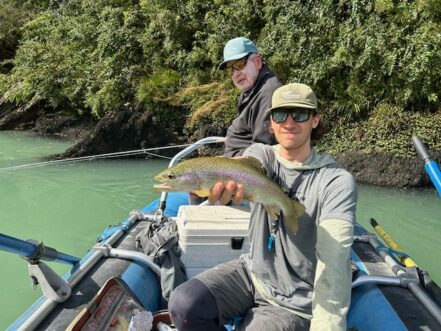
ad and pull it to the surface. At one point it came into partial view in the clear water beneath the boat and I realized it was a larger trout than I thought, likely over 20 inches, yet that in no way explained its ridiculous strength. Finally, just as we reached the lip of the rapids, I was able to bully it to the surface where Jackson was waiting with the net. Just as the fish slipped into the meshes the fly pulled free – close call! – and we got our first real look at the trout, giving a collective gasp. The fish was reasonably long – we measured it at 23 inches – but had an astonishing girth! No wonder I had such a tough time with it…it was like pulling up a halibut in trout’s clothing! We kind of sat there stunned for a moment, hardly believing what we were seeing, then pulled to shore to take some pictures of the beast. Releasing this memorable fish, we enjoyed one of Patagonian BaseCamp’s wonderful streamside meals replete with table and chairs, delicious food (their soups are to die for) and drinks, then got geared up again and began the second half of our float. The rest of the day the fishing was very consistent, with quality fish consistently coming to our dry flies. Jackson let us know that if we wanted to fish a dropper nymph off our dries we would hook even more fish, but the majority would be smaller fish in the 12”-14” range. Only in Chile do the larger fish prefer dry flies over nymphs! Towards the days end we rowed into the much larger Rio Rosselot and fished for about 30 minutes, raising several more great fish including a huge rainbow that launched spectacularly into the air for my dry, missing it completely. Sometimes the ones you don’t land stick in your mind the longest…
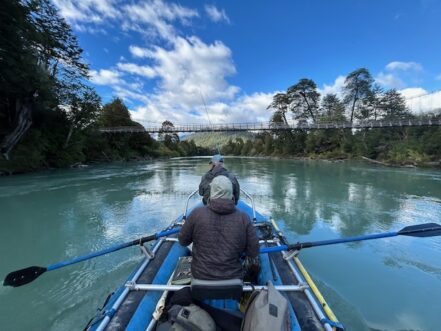
The third day I was scheduled to fish the Rio Palena on what is called the lower lodge float, putting in just behind the lodge and floating a number of miles before pulling out. I was paired with Mike this day, and I regaled him with stories of the huge brown I landed on this float the last time I’d visited the lodge. Sadly, the water was colored up from an earlier rainstorm, and while we hooked a decent number of fish for the day, it was nothing like I’ve come to expect from this amazing river. Nonetheless, it was an enjoyable day – thanks for your relentless enthusiasm, Mike! – and our guide Esteban could not have worked any harder; he obviously knew the river very well and got us into more fish than we probably deserved, given the water conditions. I stuck with a streamer for the day and Mike persevered with a dry/dropper rig – not surprisingly he hooked more fish than I did, yet it was interesting that he landed just as large of fish… surprising, as common knowledge would indicate the streamer would move larger fish. The Palena is a bit of an enigma in this way – it arguably holds the most truly huge fish, yet the few monsters I’ve landed here (fish just under 30 inches) have all taken a dry fly!
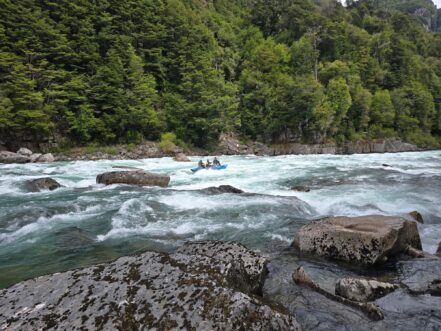
On day four I was paired with John, a wonderful guy who was supremely grateful for every moment of his trip, appreciating and enjoying every aspect of the experience Marcel has put together. Our guide was Jackson, and on the drive to put in for the upper Palena lodge float he realized the day would be a challenge, as a major tributary was unexpectedly dumping heavily-colored water into the system. Jackson had floated the same section the day before and his anglers had a spectacular day, hooking fish at a torrid pace all day long…but thanks in part to the tributary we would have a much different experience. Starting the float, we were encouraged that there was actually about three feet of visibility – not great, but plenty clear enough for the trout to be able to see our flies. Yet fishing dry/dropper and streamer tactics just did not produce, and it became evident the dirty water was not the only issue; my personal feeling is the storm we were on the edge of all day wreaked havoc on the barometer, putting the fish off the grab. A couple of hours in, Jackson’s eagle eyes spotted a nice fish suspended just beneath the surface in a small back eddy – he worked hard to hold the boat in position and John delivered the goods with a large Chubby Chernobyl. We all held our breaths watching the chunky rainbow slowly tip up, hover just beneath the fly, and finally softly sip in the bushy dry. A great team effort and victory on a slow morning! Finally, in the last hour of the day the storm broke open and we got rained on (presumably stabilizing the barometer), and combined with the clearer water of several tributaries we suddenly found ourselves into the fishing the river is known for, allowing us to finish the afternoon on a high point. Huge credit to Jackson for never giving up, staying positive, and keeping our heads in the game as he searched for a pattern to end our puzzling fish drought…and in the end it all paid off with a memorable last hour of success!
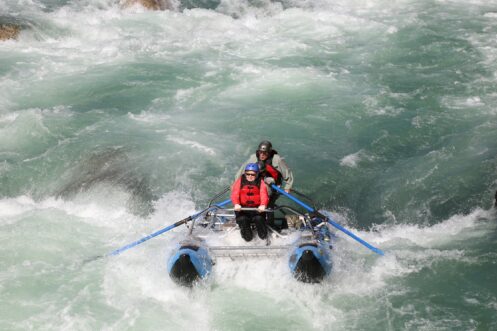 Day five dawned clear and sunny and we were all excited as Marcel had made arrangements for all six of us to enjoy our last two days experiencing his remarkable Temple Camp on the Rio Figueroa, one of the most beautiful rivers in Chilean Patagonia. “The Fig” runs clear and emerald green through a spectacularly deep canyon, punctuated by a couple of Class Four rapids and more classic trout habitat than can be imagined. I first fished this river 20 years ago when Marcel was just starting his lodge business, and immediately fell in love. Not only does the landscape resemble something right out of Jurassic Park with its dense rainforest banks and craggy mountain cliffs, the river itself is home to a healthy number of trophy browns, fish that will cause even the most experienced anglers to catch their breath. One never knows when one of these river monsters will suddenly materialize beneath your oversized dry fly, and more times than not proceed to engulf it. Landing one of these behemoths can be another story! Driving to the camp and depositing our gear in the spacious domo tents (complete with real beds, 24-hour electricity, hot water showers and flush toilets), each guide took their two anglers and headed to different locations. Today two people would fish the lower Fig float (from camp down), two would fish the upper Fig float (ending at camp), and two would float the diminutive Rio Pico, a tributary of the Figueroa. My boyhood fishing friend Craig and I were assigned the upper Fig float, which thrilled me to no end! This is the float with the two major rapids, and the place I once saw a massive brown hunkered beneath a nondescript rock ledge in just two feet of water, a fish obviously in excess of thirty inches. The memory still haunts me in a really good way! Our guide was Ben, and he was noticeably excited for the day – the Fig is one of his favorite rivers, and he thrives on the adrenaline rush of running the two rapids. We put in on the Rio Pico, a couple of hundred yards up from its confluence with the Fig, essentially launching the raft down the side of a cliff as in this rugged country there was no way to get a vehicle close to the water. Craig and I walked a trail down to the river and set up our gear as Ben prepared the cataraft for the day, and shortly we were underway, peering down into the calm, gin-clear flows of the Pico. Ben suggested we pass over this water and begin fishing once we slid into the Fig, to which we reluctantly agreed. The upper Fig float is largely one long series of heavy riffles and pockets, and rewards the angler who can efficiently cover each likely piece of holding water as it flies past. The river is loaded with trout, many in the 14”-18” range, none of whom see much pressure during the season, so are predictably naïve and susceptible to a well-fished dry and dropper rig. Craig did exactly this and by the end of the day we had no idea how many fish he had eat the dry and nymph, and in one case both – we were in disbelief as Ben landed one rainbow that had the nymph in its throat and the dry in its lips! Ben suggested I stay with a streamer to try and find one of the Fig’s beasts, and in one of the first deeper pockets we watched as a fish rose from the depths to track the fly. We both thought it was “just” a nice 20-inch rainbow…until it broke off the slow motion chase and turned down and away from us, revealing its true size and identity as one of the river’s gargantuan browns. Ben and I looked at each other with a mutual “Did you see THAT!” look and then were fast into the next set of pockets. Just before lunch we navigated the two rapids, first the two part El Diablo, followed shortly by the technical Pin Ball Wizard. Marcel hires guides who are experienced white water rowers specifically for this stretch of water, and before every descent everyone gets loaded into a life vest and helmet, and given a talk about what to do in the unlikely event they find themselves in the water (and no-one is allowed to wear waders on this float). I had supreme confidence in Ben’s ability to navigate these rapids, and my confidence was rewarded as he picked his way down each, holding his chosen line and scooting from one safe drop to another. It was honestly an amazing experience that added immensely to the day, calmly holding on as we made our way down through the bellies of the beasts. At the bottom of the last rapid we pulled over to one of the very few sandy beaches on the river where Ben set up a table and chairs and prepared lunch while Craig and I stretched our legs. I remarked how fishy the water looked right in front of our lunch spot, and heard Ben mumble that we would definitely see fish as we ate. I looked closer into the pool and could see no sign of life, and asked how he could be so sure. He just grinned and continued to stir the food. Ten minutes later as we sat eating, Ben asked if we were ready to see those trout; Craig and I hesitatingly affirmed, not quite sure how our guide planned to conjure them from apparent empty water. A slight smile on his face, he picked a few pieces of pasta salad from his plate and threw them into the shallows 15 feet away, and we were shocked as the previously still waters were instantly torn up by big rainbows tearing and slashing at the bits of food. Ben laughed at what I’m sure were Craig and my astonished expressions, and we immediately all began contributing to the shark-like feeding frenzy. I quickly took a brief video, knowing no-one would believe it otherwise! It was a good reminder of just how many fish populated this wilderness river.
Day five dawned clear and sunny and we were all excited as Marcel had made arrangements for all six of us to enjoy our last two days experiencing his remarkable Temple Camp on the Rio Figueroa, one of the most beautiful rivers in Chilean Patagonia. “The Fig” runs clear and emerald green through a spectacularly deep canyon, punctuated by a couple of Class Four rapids and more classic trout habitat than can be imagined. I first fished this river 20 years ago when Marcel was just starting his lodge business, and immediately fell in love. Not only does the landscape resemble something right out of Jurassic Park with its dense rainforest banks and craggy mountain cliffs, the river itself is home to a healthy number of trophy browns, fish that will cause even the most experienced anglers to catch their breath. One never knows when one of these river monsters will suddenly materialize beneath your oversized dry fly, and more times than not proceed to engulf it. Landing one of these behemoths can be another story! Driving to the camp and depositing our gear in the spacious domo tents (complete with real beds, 24-hour electricity, hot water showers and flush toilets), each guide took their two anglers and headed to different locations. Today two people would fish the lower Fig float (from camp down), two would fish the upper Fig float (ending at camp), and two would float the diminutive Rio Pico, a tributary of the Figueroa. My boyhood fishing friend Craig and I were assigned the upper Fig float, which thrilled me to no end! This is the float with the two major rapids, and the place I once saw a massive brown hunkered beneath a nondescript rock ledge in just two feet of water, a fish obviously in excess of thirty inches. The memory still haunts me in a really good way! Our guide was Ben, and he was noticeably excited for the day – the Fig is one of his favorite rivers, and he thrives on the adrenaline rush of running the two rapids. We put in on the Rio Pico, a couple of hundred yards up from its confluence with the Fig, essentially launching the raft down the side of a cliff as in this rugged country there was no way to get a vehicle close to the water. Craig and I walked a trail down to the river and set up our gear as Ben prepared the cataraft for the day, and shortly we were underway, peering down into the calm, gin-clear flows of the Pico. Ben suggested we pass over this water and begin fishing once we slid into the Fig, to which we reluctantly agreed. The upper Fig float is largely one long series of heavy riffles and pockets, and rewards the angler who can efficiently cover each likely piece of holding water as it flies past. The river is loaded with trout, many in the 14”-18” range, none of whom see much pressure during the season, so are predictably naïve and susceptible to a well-fished dry and dropper rig. Craig did exactly this and by the end of the day we had no idea how many fish he had eat the dry and nymph, and in one case both – we were in disbelief as Ben landed one rainbow that had the nymph in its throat and the dry in its lips! Ben suggested I stay with a streamer to try and find one of the Fig’s beasts, and in one of the first deeper pockets we watched as a fish rose from the depths to track the fly. We both thought it was “just” a nice 20-inch rainbow…until it broke off the slow motion chase and turned down and away from us, revealing its true size and identity as one of the river’s gargantuan browns. Ben and I looked at each other with a mutual “Did you see THAT!” look and then were fast into the next set of pockets. Just before lunch we navigated the two rapids, first the two part El Diablo, followed shortly by the technical Pin Ball Wizard. Marcel hires guides who are experienced white water rowers specifically for this stretch of water, and before every descent everyone gets loaded into a life vest and helmet, and given a talk about what to do in the unlikely event they find themselves in the water (and no-one is allowed to wear waders on this float). I had supreme confidence in Ben’s ability to navigate these rapids, and my confidence was rewarded as he picked his way down each, holding his chosen line and scooting from one safe drop to another. It was honestly an amazing experience that added immensely to the day, calmly holding on as we made our way down through the bellies of the beasts. At the bottom of the last rapid we pulled over to one of the very few sandy beaches on the river where Ben set up a table and chairs and prepared lunch while Craig and I stretched our legs. I remarked how fishy the water looked right in front of our lunch spot, and heard Ben mumble that we would definitely see fish as we ate. I looked closer into the pool and could see no sign of life, and asked how he could be so sure. He just grinned and continued to stir the food. Ten minutes later as we sat eating, Ben asked if we were ready to see those trout; Craig and I hesitatingly affirmed, not quite sure how our guide planned to conjure them from apparent empty water. A slight smile on his face, he picked a few pieces of pasta salad from his plate and threw them into the shallows 15 feet away, and we were shocked as the previously still waters were instantly torn up by big rainbows tearing and slashing at the bits of food. Ben laughed at what I’m sure were Craig and my astonished expressions, and we immediately all began contributing to the shark-like feeding frenzy. I quickly took a brief video, knowing no-one would believe it otherwise! It was a good reminder of just how many fish populated this wilderness river.
The group (including the guides) enjoyed a great evening at Temple, savoring wonderful conversations and a great steak and potatoes meal prepared by Nico in the snug confines of the dining cabin, the woodstove keeping the evening’s chill at bay. As discussions faded with full stomachs and great wines, we all wandered the boardwalks back to our individual tents, turning off the heaters that had thoughtfully been run during our meal, and collapsing in satisfied heaps beneath heavy comforters. Glamping at its finest!
We awoke to the wonderful aroma of Nico’s coffee and sizzling bacon, following our noses back to the dining cabin to fill our bellies in preparation for our last day of fishing. There was a general feeling of eager anticipation, along with a hint of melancholy at the realization our week had already flown past. We all switched fishing partners and floats, and I happily paired with Bob to take the lower Figueroa float. The put-in was effortless, launching our cataraft on the beach right at the camp. Bob is a Patagonian BaseCamp veteran, having visited the lodge annually the past 15 years with his wife Sue. Bob holds the lodge record fish, an enormous rainbow Marcel measured at 16 pounds! Sue sometimes takes days off from fishing, so I had the pleasure of sharing the boat with Bob on our last day of the stay. It was a wonderful day, with many fish coming to Bob’s Chubby Chernobyl – he chose to stick to a single dry fly all day – and my dry/dropper rig. The water was fast moving but free of significant rapids, and our guide Esteban stayed busy rowing back and forth across the river to hit one great bank after another. At one point Esteban pointed out a huge, half-submerged boulder that was fast approaching on the left bank, letting me know there had been a large fish holding beneath it the previous week. Quickly casting, I watched as my dry floated down toward the rock. Just as the fly bumped into its face and I began picking up to cast again a huge dark form slid into view and its mouth opened to take the artificial. Too late! I was unable to stop my pickup cast and we all groaned as the fly jerked from the fish’s mouth and rocketed into my back cast. The guide laughed and congratulated me on a fine job of rescuing my fly! The action was pretty much non-stop all day, on both the dries and (for me) the dropper – it was remarkable to see just how many fish were in this river. The take-out was memorable, a two man job involving tying the raft to a truck with a 40-foot rope, with one man manhandling it around trees as the driver slowly drug it up the side of a mountain! Driving back to the Temple Camp we collected our luggage from the night before and made the drive back to the main lodge. I took a quick picture of the mountains in front of the lodge in beautiful evening light, then, following hot showers we were treated to the chef’s traditional last night meal, an incredible lamb dish nestled in a vegetable puree that was to die for. Amazing! Afterwards we all wandered back to our rooms to pack for the next day’s departure, already missing this amazing adventure. I walked outside to take in the beautiful night sky – it is truly breathtaking down there. Took a picture (I think) of the Southern Cross.
The next morning we loaded our gear and ourselves into a couple of Toyota Hilux trucks and made the drive to Chaiten through two hours of absolutely gorgeous country. Back home we would have been paying fifty bucks to a national park service to drive through such a wild, spectacular landscape! Arriving at the small Chaiten airport we checked our luggage to Puerto Montt, and then enjoyed the 30-minute charter flight above the fjordlands. We were met at the charter airport by Marcel’s transfer driver, who drove us across town to the main Puerto Montt airport. Here we checked our luggage to Santiago and waited a couple of hours for the flight – it was a great place to pick up some souvenirs and a quick snack. Back in Santiago we collected our luggage at the domestic airport where we landed, and walked it a couple of hundred yards to the international airport. There are free rolling luggage carts if needed, and it is a pretty easy walk on a very wide sidewalk. For those wanting to spend the night in Santiago and make it as easy as possible, there is a Holiday Inn right on this walkway between airports, making transfers effortless. I had a 6 hour layover in Santiago and they wouldn’t take my luggage until 4 hours prior to the flights, so I found a seat in the airport and caught up on my reading and emails for a couple of hours. At the appropriate time I got in the United Airlines luggage check line, where everyone uses one of the dozens of computer stands to check their luggage, and the machine also prints out your boarding passes for all your flights home. There were several friendly United employees wandering around this area, helping everyone who was struggling with the machines – this included me as I needed help with my overweight baggage. A super nice lady quickly got me squared away. As I was waiting in line to drop my luggage I heard a voice behind me say, “Is that Redding”? Turning, a guy was pointing at the RDD luggage sticker on my bag. I confirmed it was indeed, and he let me know that his dad lives in Redding! Small world! Dropping my checked luggage I found Mike – who had survived 4 weeks of traveling and fishing with me and was flying home on American – and we found a nice restaurant to eat dinner at before boarding our respective overnight flights home. An hour later, nestled in my seat on the airplane, I checked the movie selections as I don’t sleep on planes. Nine hours later we landed in Houston where I collected my checked luggage at the carousel, rolled it through Immigration and re-checked it all the way home. I then walked a short distance to my departure gate for the flight to San Francisco, picking up a big Cinnabon and water on the way (having chosen to pass on the airline breakfast). The flight to San Francisco was quick and uneventful, as was the hour-long flight to Redding, where I was met and driven home, tired and a little rummy, but very grateful for an extended, wonderful stay in Patagonian Chile, still one of my favorite places on Earth.
What I Fished at Patagonian BaseCamp:
- Rods:
- Winston Air 2 Freshwater – 9’ 6-weight
- Winston Air 2 Max – 9’ 7-weight
- Reels:
- Galvan Torque – T-6
- Fly Lines:
- Waders:
- Wading Boots:
- Clothing:
- Sunglasses:
- Smith Guides Choice XL – Brown Lens
Mike Mercer
Travel Specialist
mercer@theflyshop.com | 800-669-3474 | 530-222-3555

